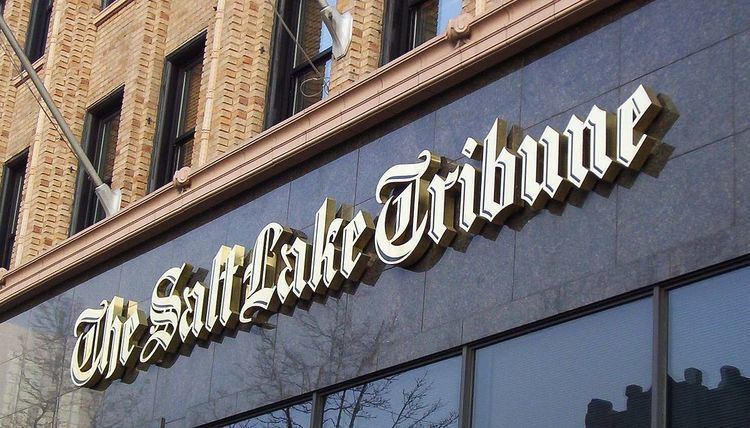Type Daily newspaper Owner(s) Paul Huntsman | Editor Jennifer Napier-Pierce | |
 | ||
Founded 1870 (as the Mormon Tribune) Headquarters 90 South 400 WestSuite 700Salt Lake City, Utah 84101 United States | ||
The Salt Lake Tribune is a daily newspaper published in the city of Salt Lake City, Utah, with the largest weekday circulation but second largest Sunday circulation behind the Deseret News. The Tribune, often referred to as just "the Trib," is owned by Paul Huntsman and printed through a joint operating agreement with the Deseret News through the Newspaper Agency Corporation. For almost 100 years it was a family-owned newspaper held by the heirs of U.S. Senator Thomas Kearns. After Kearns died in 1918 the company was controlled by his widow, Jennie Judge Kearns, and son, Thomas F. Kearns. The newspaper's longtime publisher was John F. Fitzpatrick, who started his career as secretary to Senator Kearns in 1913.
On April 20, 2016, Huntsman Family Investments, a private-equity firm headed by Paul Huntsman, announced that they would be buying the Tribune.
The newspaper's motto, at the top of its masthead, is "Utah's Independent Voice Since 1871."
History
A successor to Utah Magazine (1868), the publication was founded in 1870 as the Mormon Tribune by a group of businessmen led by former members of The Church of Jesus Christ of Latter-day Saints (LDS Church) William Godbe, Elias L.T. Harrison and Edward W. Tullidge, who disagreed with the church's economic and political positions. After a year its name was changed to the Salt Lake Daily Tribune and Utah Mining Gazette, but soon after that, the name was shortened to The Salt Lake Tribune.
In 1873 three Kansas businessmen, Frederic Lockley, George F. Prescott and A.M. Hamilton, purchased the company and turned it into an anti-Mormon newspaper which consistently backed the local Liberal Party. Sometimes vitriolic, the Tribune held particular antipathy for LDS Church president Brigham Young. In the edition announcing Young's death, the Tribune wrote,
He was illiterate and he has made frequent boast that he never saw the inside of a school house. His habit of mind was singularly illogical and his public addresses the greatest farrago of nonsense that ever was put in print. He prided himself on being a great financer, and yet all of his commercial speculations have been conspicuous failures. He was blarophant, and pretended to be in daily [communion] with the Almighty, and yet he was groveling in his ideas, and the system of religion he formulated was well nigh Satanic. — The Salt Lake Tribune, August 30, 1877In 1901 newly elected United States Senator Thomas Kearns, a Roman Catholic, and his business partner, David Keith, secretly bought the Tribune. Kearns made strides to eliminate the paper's anti-Mormon overtones, and succeeded in maintaining good relationships with the mostly-LDS state legislature which had elected him to the Senate. After Keith died in 1918 the Kearns family bought out Keith's share of the Salt Lake Tribune Publishing Company.
In 1902 the company started up an evening edition, known as The Salt Lake Telegram. The Telegram was, from the beginning, a money loser, and was sold in 1914 and reacquired by the Tribune in 1930 only to be sold to and merged into the Deseret News, Salt Lake's daily newspaper owned by the LDS Church, in 1952.
John F. Fitzpatrick became publisher in 1924 and worked closely with Tribune and Telegram president Thomas F. Kearns, Sr. until 1952 when Kearns sold his controlling interest. In 1952 the Tribune entered into a joint operating agreement with the Deseret News and created the Newspaper Agency Corporation. Fitzpatrick was the architect of NAC and the Kearns–Tribune's investment into the cable business. In 1960 Fitzpatrick died of a heart attack. He had no appointed successor. An emergency session of the Kearns–Tribune Corp. board selected John W. Gallivan as the next publisher. He remained in that position until 1984 and chairman of the board until 1997.
The Kearns family owned a majority share of the newspaper until 1997 when they merged with Tele-Communications Inc., a multimedia corporation, which was later acquired by AT&T Corporation. The Tribune was subsequently sold to Denver, Colorado-based MediaNews Group in 2000.
In 2002 the Tribune was mired in controversy after employees sold information related to the Elizabeth Smart kidnapping case to The National Enquirer. Tribune editor James "Jay" Shelledy resigned from his job at the paper amidst the fallout of the scandal. Two staffers also were removed from their positions as Tribune reporters.
In 2004 the paper decided to move from its historic location at the downtown Tribune building, to The Gateway development. Many people, including several Tribune employees, opposed the move, stating that it would harm the economy of Salt Lake's downtown. The move was completed in May 2005 and Tribune employees were told by Editor Nancy Conway, "It is just a building."
After emerging from bankruptcy in 2010, MediaNews Group lost control of its ownership to a hedge fund, Alden Global Capital. "The remainder of the Denver-based chain is owned by a consortium of lenders and by Singleton himself."
In 2012, as it had in 2008, The Salt Lake Tribune endorsed Barack Obama for the presidency, despite opponent Mitt Romney's connections with both Mormonism and Salt Lake City, having had a hand in organizing their 2002 Olympic Games.
